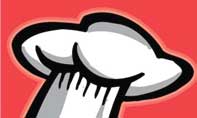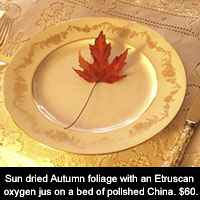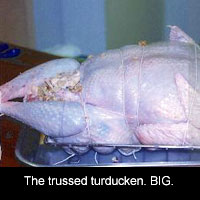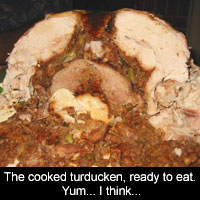- About Us
- Columns
- Letters
- Cartoons
- The Udder Limits
- Archives
- Ezy Reading Archive
- 2024 Cud Archives
- 2023 Cud Archives
- 2022 Cud Archives
- 2021 Cud Archives
- 2020 Cud Archives
- 2015-2019
- 2010-2014
- 2004-2009
 |
Ezy Reading: Time to Gorge |
I recently had the opportunity to meet a New York chef of some note, and in chatting I asked what was perhaps one piece of insider truth folks might be interested in hearing about the behind-the-scenes world of high-end cuisine. He pondered the question for a moment, and then, if memory serves correctly, offered something pretty much along the lines of this:
"The whole mess of supposedly innovative and daring food you see on plates designed by hot-shot chefs today is often a crock of baloney. It's a whole mutton-dressed-as-lamb scenario. They'll offer you a perfectly-proportioned cube of beef five times smaller than a normal steak, put it on a large white plate with a squiggle of herb sauce next to it, slap a price tag on it large enough to replicate the cost of a Volkswagon, and they think that's what high-end dining is all about. Worst thing is, diners will lap this stuff up and gladly reach for their AMEX with glee, completely unaware of the fact they've just been conned because the menu description contained words like 'jus', 'fusion' and 'confit' which made them horny. Yes, there is an art to fine dining, and yes a strong chef should be innovative and willing to explore new ingredients, methods and forms of presentation, this is true. But half they time, they've got the ingredients for a rabbit stew which would be perfectly fine on any competent menu, but instead have decided to stuff everything with everything else, deep fry it, and expect people to call them geniuses. And stuffing things? Man, diners here just love ordering things that have been stuffed. I'm sure there's some sort of modern America capitalist gluttony theory you could trot out here about excess of empire, but you stuff it, they'll eat it, regardless of the fact they're now forcing eighteen things into a mouthful instead of one."
I've kept in mind the chef's rant when looking at different restaurant fare since, and I have to say, oftentimes from my own dining experiences, he certainly seems to be correct. It's kind of like why I've never 'gotten' abstract art. I'm sure there's a skill involved, I'm sure it takes years of practice and study to get to a certain point of competency, but that painting still looks to me like the 'artist' merely swallowed five tubes of acrylic, vomited on a canvas, and sold the damn thing for $80,000 to an idiot with too much cash. That idiot then hung it on the wall in his fancy house where he spent they next fifteen years musing with dinner party guests about 'the deep irony and symbolism reflected in every brush stroke'. Bollocks. As my Grandmother Helen would have said, sweating over hotplates at the Warren Lunch in Peabody, Massachusetts, "I don't care if it looks fancy or looks like phooey. If it tastes good, then just shut up and eat." And I'm telling you now, her turkey pot'pie didn't look pretty, but damn was it tasty.
 Still, for those of you that enjoy the gluttonous offerings of things stuffed and stuffed again, prepare to meet your Holy Grail. From Cajun Louisiana may I introduce you to the turducken. Read about the turducken, cook the turducken, eat the turducken, and then bolt for your nearest Roman vomitorium while cursing the turducken. It is certainly something 'different' in food, high'end or not.
Still, for those of you that enjoy the gluttonous offerings of things stuffed and stuffed again, prepare to meet your Holy Grail. From Cajun Louisiana may I introduce you to the turducken. Read about the turducken, cook the turducken, eat the turducken, and then bolt for your nearest Roman vomitorium while cursing the turducken. It is certainly something 'different' in food, high'end or not.
Bon Appetit!
The Turducken:
(with thanks to http://fp.thesalmons.org/lynn/turducken.html)
Basic Needs:
*7-9 kg whole turkey
*2'2.5 kg whole duckling
*1.5-2 kg whole chicken (or use a larger chicken and place the duckling inside it)
* corn bread dressing
* sausage stuffing
* large roasting pan and rack
* cotton string
* large needle and cotton thread
Debone the birds:
Sharpen those knives! Maximize your work area so you have plenty of room and light. Use the kitchen table if there's not enough counter space. If it is your first time deboning a fowl, it is advisable to practice first on the chicken rather than the turkey since mistakes will be hidden inside the bigger birds.
Rinse the turkey and remove the neck and any giblets. Place the turkey, breast side down, on a clean flat surface. Cut through the skin along the length of the spine. Using the tip of a knife and starting from the neck end, gently separate meat from rib cage on one side. Toward neck end, cut through the meat to expose the shoulder blade; cut meat away from and around the bone, severing bone at the joint to remove shoulder blade. Disjoint wing between second and third joints. Leave the wing bones and keep the wing attached to the meat.
Continue separating meat from frame, heading toward the thighbone and being careful to keep the ...oyster... (pocket of meat on back) attached to skin, rather than leaving it with the bone. Cut through ball'and'socket joint to release the thighbone from the carcass (bird will be open on one side, exposing bones left to deal with). Keep the leg attached to the meat.
Repeat boning procedure on the other side of the bird. Carefully remove the carcass and use it to make stock. Stock is needed for making stuffing and more stock is needed for gravy. To make stock, put the turkey carcass in a large pot and cover with water. Bring to a boil, then simmer on low heat overnight.
 You should end up with a flat boneless (except for wings and legs) turkey with the skin intact in one large piece. Put the boned turkey in a large dish or bowl and cover with plastic wrap to keep it from drying out. Place it in the refrigerator.
You should end up with a flat boneless (except for wings and legs) turkey with the skin intact in one large piece. Put the boned turkey in a large dish or bowl and cover with plastic wrap to keep it from drying out. Place it in the refrigerator.
Repeat the deboning process on the duckling and the chicken, but debone both stumps of wings and leg drumsticks. Cut through flesh at the thinnest point and trim around these bones with a knife until they can be removed. (Since they have little meat, we usually cut off the entire wings and add them to the stockpot.) Both the chicken and duck will be stuffed inside the turkey and need not be kept ...perfectly... intact.
Trim excess skin and fat from necks of birds. Ducks, in particular, have a lot of excess fatty skin that should be saved to render fat to be used later for making gravy.
Prepare seasoning mix and set aside:
* 2 tablespoons salt
* 2 tablespoons paprika
* 1 tablespoon black pepper
* 1'2 teaspoons dried thyme
Sausage stuffing:
Melt butter in large skillet over high heat. Add 3 cups onions and 1-1/2 cups celery. Saute until onions are dark brown but not burned, about 10 to 12 minutes. Add 1 kg sausage (we prefer spicy Italian sausage) to the skillet and cook about 5 minutes or until the meat is browned, stirring frequently. Add paprika (3 tbsp.) and minced garlic (3 tbsp.) and cook approximately 3 minutes over medium heat, stirring occasionally. Stir in 3 cups of stock and bring to simmer. Continue cooking until water evaporates and oil rises to top, about 10 minutes. Stir in 2'3 cups toasted breadcrumbs and mix well. Add more bread crumbs if mixture is too moist.
Cornbread stuffing:
Thoroughly combine 4 tablespoons ground turmeric, 2 teaspoons salt, 1'1/2 teaspoons white pepper, teaspoon cayenne, 1 teaspoon black pepper, 1 teaspoon dried oregano leaves, 1/2 teaspoon onion powder and 1/2 teaspoon dried thyme leaves, and se the seasoning mix aside.
In a large skillet, melt one stick of butter with 3/4 cup onions, finely chopped onions, 3/4 cup green capsicum, finely chopped, 1/2 cup celery, finely chopped, 1 tablespoon chopped garlic, and 2 bay leaves over high heat. Sauté about 2 minutes, stirring occasionally. Add the seasoning mix and continue cooking until vegetables are barely wilted, about 5 minutes.
Stir in 300 grams turkey, duck or chicken giblets, boiled until tender then finely chopped, 1 cup turkey, duck or chicken stock, and 1 tablespoon Tabasco. Cook for 5 minutes, stirring frequently. Remove from heat. Add 5 cups of finely crumbled cornbread, 1-2 cups evaporated milk and 3 eggs, stirring well. Spoon dressing into a greased 9x13... baking pan. Bake at 175 degrees C until browned on top, about 35'40 minutes and then allow to cool.
Assembly:
At least 10 to 11 hours before dinner, assemble the Turducken.
Spread the turkey, skin down, on flat surface, exposing as much meat as possible. Rub 3 tablespoons of seasoning mix evenly on meat. Spread sausage stuffing over the turkey in an even layer approximately 3/4 inch thick.
Place duck, skin down, on top of stuffing. Season exposed duck meat with about 1 tbsp. of seasoning mix. Spread corn bread stuffing in an even layer (about 1/2 inch thick) over the duck.
Arrange the chicken, skin down, evenly on top of corn bread stuffing. Season chicken meat with seasoning mix. Spread remainder of sausage and/or corn bread stuffing on top of chicken. The assemblage will look something like this.
With another person's help, carefully lift the sides of the layered birds, folding the sides of the turkey together. Have a helper hold the bird while sewing the opening down the back of the turkey together using cotton thread. The bird may not close perfectly, and a strip of cheese cloth can be used to help close the ...crack... in the back of the turkey so stuffing will not leak out when the bird is turned over.
Since the turducken has no skeleton, it must be trussed up or it may fall apart in cooking. Tie 4-5 pieces of cotton string around the bird, widthwise to act as skeletal support. Turn the bird over and place in a roasting rack inside a large roasting pan so it is oriented breast side up and looks like a ...normal... turkey. Tie the legs together just above the tip bones.
Cooking:
Heat oven to 105 degrees C. Temperature control is critical since the turducken is so massive that it has to be cooked slowly at a low temperature to prevent burning the outside before the interior is cooked. Using an oven thermometer is highly recommended. We place 2-3 oven thermometers at different locations within the oven to monitor oven temperature. We also use a meat thermometer inside the bird to measure its internal temperature.
Place the bird in the center of the oven and bake until a meat thermometer inserted through to center reads 75 degrees, approximately 9 hours, though cooking times will vary depending on the size of the birds and amount of stuffing used. Rely on temperature and not time cooked for doneness.
 There will be no need to baste, but accumulated drippings may need to be removed from the pan every few hours so that the lower portion does not deep fry in the hot oil. Save pan drippings for gravy. Remove the turducken from the oven and let cool in the pan for an hour before serving. Make gravy according to your favourite recipe.
There will be no need to baste, but accumulated drippings may need to be removed from the pan every few hours so that the lower portion does not deep fry in the hot oil. Save pan drippings for gravy. Remove the turducken from the oven and let cool in the pan for an hour before serving. Make gravy according to your favourite recipe.
To serve cut bird in half. Carve crosswise so each slice reveals all 3 meats and stuffings. Will make 15 to 25 servings.
Simple Gravy:
Take 1 cup of pan drippings plus 1 cup of flour and cook over medium heat until ...tan.... Add 10 cups stock to fat/flour all at once. Whisk thoroughly. Bring back to a boil and then simmer for 5 min. Whisk constantly. Add salt + pepper + paprika ...to taste....
The gravy can be made in advance and allowed to stand over low heat for at least 2 hours (maybe more). We usually make at least two batches.
Drop by for the latest edition of Ezy Reading every Monday.
